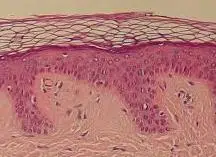Before entering fully into the definition of the term dermis, let's know its etymological origin. In this case, we can state that it is a word that derives from Greek, specifically, it comes from "derma, dérmatos", which can be translated as "skin".
The notion of dermis is used to refer to the layer of skin that is below the epidermis . The dermis is thicker than the epidermis and is connected to it.
 The skin is the largest organ in humans and animals . It has three main layers: the dermis is the intermediate one, located between the epidermis (the superficial layer) and the hypodermis (the lowest layer).
The skin is the largest organ in humans and animals . It has three main layers: the dermis is the intermediate one, located between the epidermis (the superficial layer) and the hypodermis (the lowest layer).
Composed of elastic fibers of the connective tissue and smooth muscle fibers, two other layers are distinguished in the dermis itself. The upper dermis , also known as the papillary layer , is the superficial region that is linked to the basement membrane and has touch or pressure receptors. Specifically, in this layer it must be emphasized that there are both collagen and elastic fibers, capillaries and reticular fibers.
The deep dermis or reticular layer , for its part, houses various skin annexes. In the dermis there are also nerves, glands, hair follicles, lymphatic vessels, blood vessels and Meissner's corpuscles.
The main function of the dermis is defensive , offering protection against trauma and injury. It is also responsible for providing nutrition to the epidermis through its blood capillaries, gives elasticity to the skin and performs a sensitive function (detects cold, heat, etc.).
When exposed to heat , the dermis' blood supply expands through vasodilation. On the other hand, when faced with cold , this irrigation contracts due to vasoconstriction.
Other interesting data about the dermis are the following:
-In addition to those mentioned, it performs important functions such as acting as a fluid reserve, developing a barrier function against what are infectious processes that affect the skin, stimulating the production of collagen fibers and even exerting a relevant and essential weight in what is wound healing.
-It is related to different elements of the body such as hair, sebaceous glands, sweat glands and blood vessels.
-It must be established that when the skin aging phase takes place, the dermis, as it could not be otherwise, is also damaged. Specifically, it is your cells that are affected by this process in which collagen, for example, is significantly reduced.
-There are various diseases that exist and that affect the different layers of the skin, such as the dermis. However, among the most common we can highlight acne , dermatitis, psoriasis, melanoma, eczema, hives, warts , sunburn...
It should be noted, on the other hand, that the leather obtained from animals is produced by tanning the dermis and subjecting it to different processes until the desired finish is achieved.
